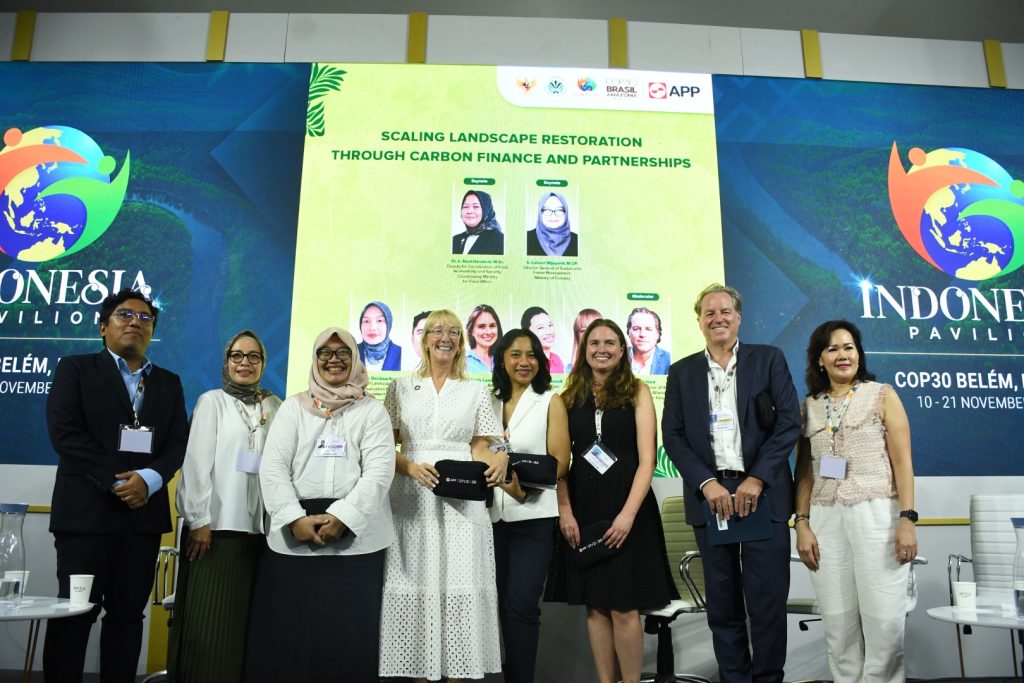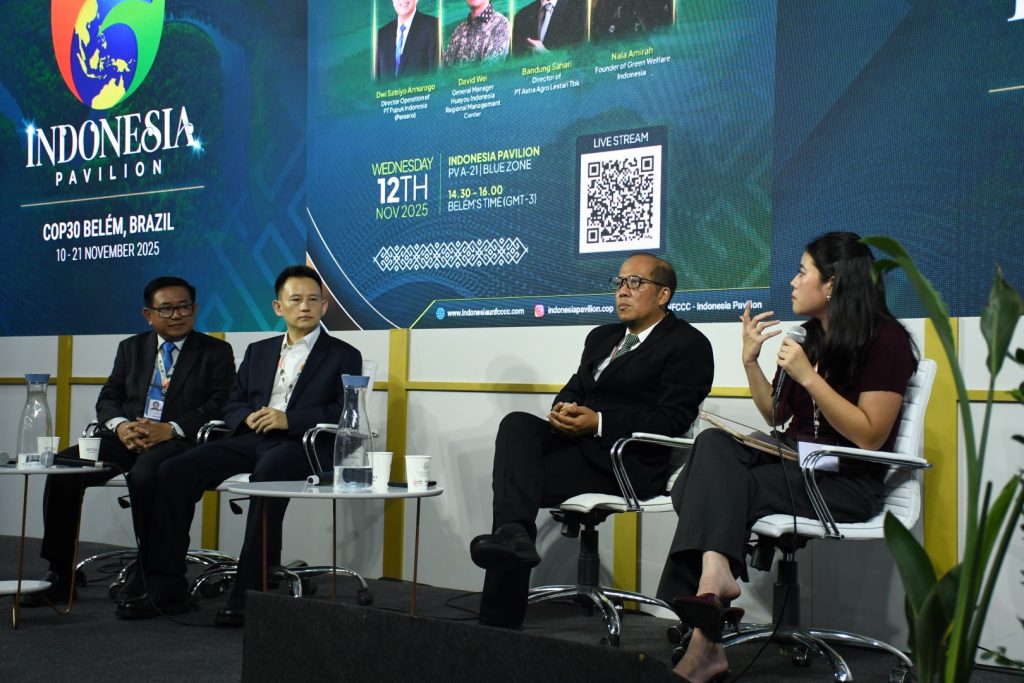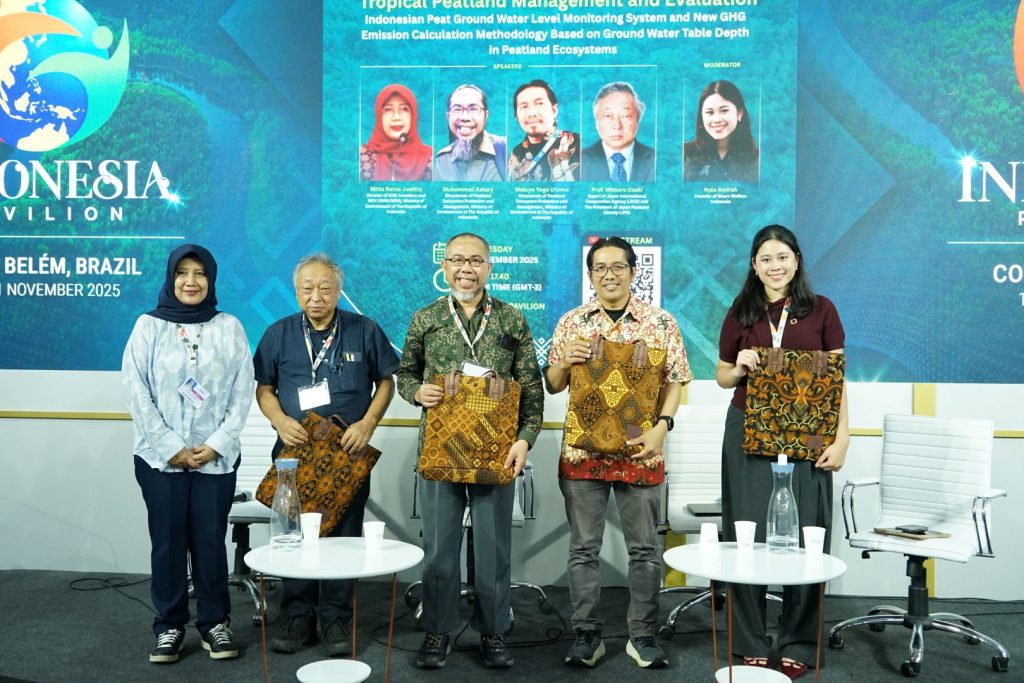Belém, Brazil, 12 November 2025, In a comprehensive single-day program at the Indonesia Pavilion at COP30 Amazonia Brazil 2025, Indonesia presented its national climate strategy, moving decisively from high-level policy to large-scale, verifiable implementation. The five consecutive sessions on November 12, 2025, connected the dots between new green industries, functioning carbon markets, a pro investment policy framework, the decarbonization of heavy industry, and peatland science. The message was clear: Indonesia’s climate plan is not just a promise. It is an economic strategy that is already working, with new policies, real market deals, and strong industry leadership.
Here are the sessions of 12 November 2025 in Indonesia Pavilion :
The day began with an innovation theme. The “Accelerating Sustainable Fuel” session showed how Indonesia is turning waste (Used Cooking Oil, or UCO) into a high-value green product: Sustainable Aviation Fuel (SAF).
Pertamina is leading this “Waste to Wings” program. Agung Wicaksono, a Pertamina Director, explained the key technology: “Through a joint work between Pertamina and a leading technical university, ITB, we established what we call ‘Katalis Merah Putih’ (Red and White Catalyst)”. This Indonesian-made catalyst has already been used in commercial flights. The strategy is underpinned by a 1% blend mandate by 2027 and community-based collection programs, Indonesia is building a new, circular industry.

2. CARBON CONNECTION FOR CLIMATE ACTION
The “Carbon Connection: Seller Meets Buyer” session was not just talk; it was about “from discussion to implementation”. The session moved beyond theory to implementation with a live Letter of Intent signing ceremony between Pertamina NRE and Sumitomo Mitsui Banking Corporation (SMBC) Indonesia for the procurement of geothermal carbon credits. In this session, Prof. Bambang Brodjonegoro emphasized that this market is built on credibility. “The quality of asset will be the game changer,” he stated, positioning Indonesia’s high-integrity, verified projects as “blue chip” assets for global investors.

3. A2 – SCALING LANDSCAPE RESTORATION THROUGH CARBON FINANCE AND PARTNERSHIPS
The "Scaling Landscape Restoration" session unveiled the foundational policy The Economic Value of Carbon and National Greenhouse Gas Emission Control in Indonesia : Presidential Regulation (Perpres) 110 of 2025. This policy is a "paradigm shift." Edo Mahendra, Principal Advisor to the Ministry of Forestry, said the carbon market is no longer an afterthought. "Before it was residual, now it is instrumental for the achievement of our NDC and the FOLU Net Sink 2030". The policy, which opens international carbon trading and offers 30+ year restoration licenses. Marisa Drew of Standard Chartered praised this, saying it solves the investor's biggest worry about "permanence".

The “Synergizing Nature and Technology” session showed that Indonesia’s main industries are already acting. Industry from “hard-to-abate” sectors showed their dual strategy : using high tech solutions and nature based solutions. PT Pupuk Indonesia is planning its transition to “Blue and Green Ammonia”. It is also launching a massive “Agroforestry Carbon Alliance” to plant 109.5 million trees, designed to absorb the exact amount of its future residual emissions. PT Astra Agro Lestari’s Director, Bandung Sahari, called methane capture from palm oil waste (POME) the most powerful technology they use. It cuts 60 to 70% of total greenhouse gas emission from their mills and creates clean energy. Huayou Indonesia showed how its advanced nickel processing technology uses “1/8 of the energy” of older methods. David Wei, the General Manager, also revealed a new “slurry pipeline” that cuts transport emissions by 59%. He also announced a new technology to address tailing storage challenges by recovering iron and sulfur from Hazardous and Toxic Waste.

5. B4 – TROPICAL PEATLAND MANAGEMENT AND EVALUATION
The final session of the day provided the scientific proof that Indonesia’s peatland strategy works and profitable. Mitta Ratna Juwita of the Ministry of Environment, Republic of Indonesia said in her keynote, “Productivity and restoration can go hand in hand”. Muhammad Askary of the Ministry of Environment, Republic of Indonesia presented the SIMATAG system. This system uses 10,100 monitoring points to create the biggest database in monitoring of pit ground water in the world. This massive dataset feeds a new (Tier 2/3) model that accurately calculates emission reductions. Most importantly, the session proved that restoration is good for the economy. Data showed that keeping peatlands wet (at the -0.4m rule) creates the perfect humidity for oil palm pollinator insects. This has increased palm oil productivity by 13-30%. Prof. Mitsuru Osaki (JICA/JPS) introduced AeroHydro Culture (AHC), a new technology that mimics how native trees use aerial-like roots. In trials, AHC increased yields by 36% on wet peatland compared to standard fertilizer.

In a single day, Indonesia demonstrated a complete, vertically integrated system: a national strategy built on science, enabled by pro-investment policy, executed by innovating industries, and verified by a world-class monitoring and market system.



